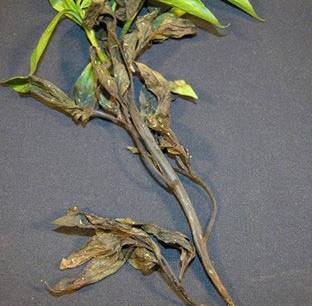Arkansas Plant Health Clinic Disease Notes
Contact
Plant Diagnostician
Phone: (479) 575-2727
Email: ssmith@uada.edu
Jason Pavel
Diagnostician
Phone: (479) 575-7257
Email: jpavel@uada.edu
University of Arkansas System Division of Agriculture
Cralley Warren Building
Room 16
2601 N. Young Ave.
Fayetteville, AR 72704
Peony Phytophthora Blight
by Sherrie Smith and Jason Pavel
Plant Health Clinic Disease Note Issue 9

Peonies planted in locations with poor drainage may develop Phytophthora Blight and Stem Canker caused by Phytophthora cactorum.
What are the symptoms of peony blight?
Symptoms begin as small water- soaked spots on emerging shoots, stems, petioles, buds, or leaves. The spots become dark brown to black, leathery, elongated lesions.
A wet rot occurs when crowns and roots are infected, causing the collapse and death of the entire plant.
How do I treat peony blight?
Once symptoms are noticed, chemical treatments are usually not effective. All parts of the infected plant and the immediate soil should be removed from the planting.
Peonies should not be replanted in that location until drainage issues are resolved and infested soil has been replaced.

Peony Phytophthora Blight- Phytophthora cactorum (Photo by Keiddy Urrea, formerly University of Arkansas System Cooperative Extension Service)
Take Aways:
- Do not overwater.
- Improve drainage.
- Remove all parts of infected plants.
- Replace soil if practical.
Follow us on Facebook!
This work is supported by the Crop Protection and Pest Management Program [grant no. 2017-70006- 27279/project accession no. 1013890] from the USDA National Institute of Food and Agriculture.